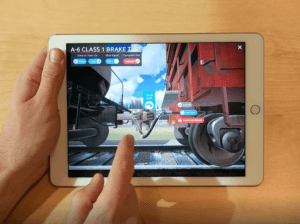The benefit of simulated training is that it offers learning opportunities virtually anywhere (web, mobile, pc) – but PowerPoint style courses are also available anytime, anywhere and their ineffectiveness as a ‘retained knowledge’ learning tool is well documented. Why, then, are we expecting a new form of observational training to do any better? For simulated training to be effective, it needs to offer immediate, visual feedback.
 The Old Way – Observational:
The Old Way – Observational:
I will tell you what I am going to tell you
I will tell you
I will test you on what I just told you
The New Way – Immersive & Interactive:
I will show you
You will do it
You will understand failures and euphorias
You will do it again, at regular intervals.
Immediate, Visual Feedback
As John Medina, a University of Washington biologist who has conducted extensive research into persuasion and how the brain processes information, shares in his book Brain Rules, “We are incredible at remembering pictures. Hear a piece of information, and three days later you’ll remember 10 percent of it. Add a picture and you’ll remember 65 percent.”
But although this is a step in the right direction, merely seeing an image is often not enough on its own to solidify learning, particularly when the expected outcomes you’re training for involve motor skills – and many outcomes do. This means our trainings must not only be visual, but immersive and offering immediate feedback. How so? As Tom Maddox, Ph.D. explains,
“immediate feedback training is optimal because learning is a brain-based process that involves strengthening appropriate neural connections, and weakening inappropriate neural connections. This strengthening or weakening must be initiated while the neurons are active, and thus immediately following the behavior of interest. The critical factor is the neurotransmitter dopamine that initiates the strengthening and weakening of synaptic connection associated with the behavior of interest. When the release of dopamine into the synapse is linked with the neural activation, learning is optimized.”
And we need all the help/connections we can manage, as humans are notoriously awful when it comes to memorization – at least when it involves something we’re struggling with! The trick, according to Nikhil Sonnad, “lies in convincing your brain that the information matters. In other words, you have to overcome the ‘forgetting curve.’”
Remember That Dog Down the Street?
Remember that dog that always barked as you rode by on your bike as a child, so you’d speed up as you got close in case it was ever outside? You may even remember the dog’s name, maybe not – but you remember details about the dog and where it lived. Why is that? It doesn’t affect you today, that’s for sure. But it’s startling information that was important to your well-being and it made an impression – one that stuck. Making similar impressions to the less startling, but exceptionally important trainings we must master, means finding other ways to overcome our (quite steep) forgetting curve. Spaced repetition is key:
“The downward slope of the forgetting curve can be softened by repeating the learned information at particular intervals. This principle is the foundation of the learning method known as ‘spaced repetition,’ where material is learned then reviewed after increasingly large time gaps.” The 70:20:10 framework supports this thinking: “10 percent of what people learn comes from formal learning events such as courses and classes; 20 percent comes from informal, peer-to-peer learning; and 70 percent is experiential. This means that the clear majority of what people learn comes from on-the-job training, trial and error, and simply learning by doing.” And THIS is where simulated learning shows its true value. It offers the businesses the ability to provide repeated, consistent and interactive training anytime, anywhere.
Watch Norfolk Southern deploy an experiential training application –
But, as with any metric – the proof is in the ROI, and appreciating the many ways it can be measured . . .
Measuring Training Effectiveness
So how do you sort out whether this sort of training is worthwhile – and what are you measuring, specifically anyway? The two models frequently referenced are the Kirkpatrick Model of Evaluation and the Philips ROI model – and we offer some thoughts around measuring the magnitude of the training task in $$ here and overarching view of the surprising ROI simulated training offers here! Outside of that, we advise companies to have training effectiveness measures in place – and have outlined top outcomes to track, which could look like this:
Level 1: Reaction
100% of the survey respondents found the virtual interactive training engaging.
92% of the respondents agreed that the virtual interactive training is relevant to their jobs.
Level 2: Learning
After the implementation of the virtual interactive training, 84% passed the skills assessment on the first try (vs. 50% prior to implementation).
Level 3: Job Application
The technicians were observed in a subsequent Quality Assurance audit.
The findings showed that they were able to perform the procedure with 92% accuracy, compared to 58% prior to implementation.
Level 4: Results/ Business Impact
50% saving of training time (from 2 days to 1 day)
QA scores improved by 50% for every task measured.
Time to maintain & service the equipment improved by 62% over a six-month period.
And best of all about those stats? They’re from actual results we’ve seen – though didn’t want to overwhelm the post with links! We’re always happy to share both successes and struggles (check out some of our client interviews to see for yourself!) and to help you think through how simulated training can look for you.


